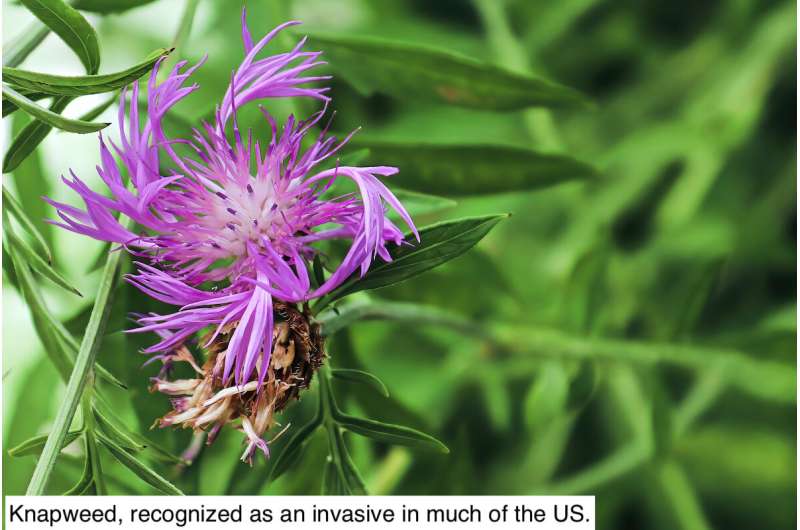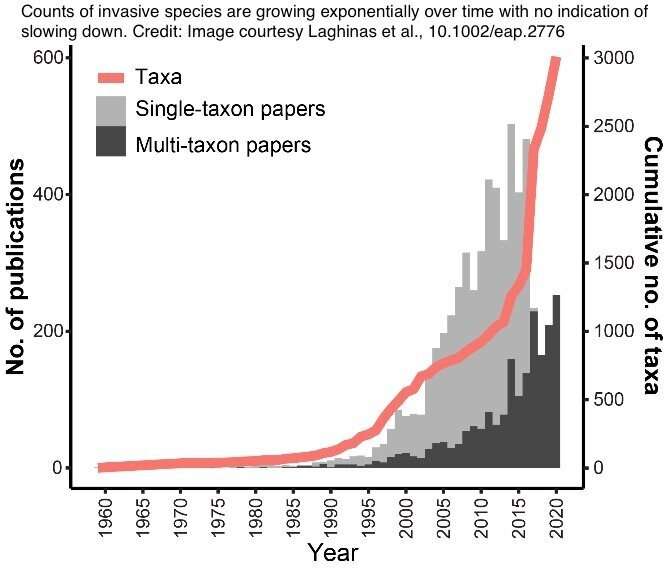Invasive plant species are increasing exponentially, but no one knows how many species there are

Invasive plants can have devastating effects on local ecologies, comparable to the effects wrought by global warming. And yet, there is currently no reliable understanding of how many invasive plant species there are in the world. New research, led by the University of Massachusetts Amherst and recently published in Ecological Applications, is the first to comprehensively pinpoint the various unknowns that must be addressed in order to intelligently manage invasive species around the world.
The most cost-effective method of stopping invasive species is to put a halt to their introduction. In order for this to happen, managers need to know exactly which plants are invasive. Existing lists of global invasive plants include species that have been reported by scientists, but species that haven't yet been reported as invasive still pose a risk. The team at UMass Amherst, led by Brittany Laginhas, who completed the research as part of her graduate work at UMass, mined a database of 5,893 studies, stretching back to 1959, to paint the most complete picture of the world's invasive species yet.
"Trade and climate change have facilitated the widespread movement of species around the globe," says Laginhas, the paper's lead author. "In some cases, these species will establish and spread in their new environment, causing devastating ecological and economic damages. Basic information on invasive species, including which species are invasive, where they have invaded, and their timing of invasion, is critical for developing strategies to prevent their spread and subsequent damages."

"We're capturing about two-thirds of the invasives that have been reported in the literature," says Bethany Bradley, professor of environmental conservation at UMass Amherst, and the paper's senior author.
Perhaps the most shocking result is that the numbers of invasive species seem to be increasing exponentially, with no sign of starting to level off. Though the team uncovered 3,008 total invasive species reported in the 5,893 papers, their statistical modeling suggests that there should be 4,721 species—though the identity of those missing 1,713 species remains a mystery.
Though there could be many explanations for why so many invasive species are missing from the literature, it's also clear that there has been a systemic and geographically uneven undercount. While North America has been relatively well studied, Central and South America and Oceania haven't been given equal attention. "There are vast differences in the studies conducted across different continents," says Matthew Fertakos, one of the paper's co-authors and a graduate student in organismic and evolutionary biology at UMass Amherst. "We have statistical methods that can help tell us how many species there should be, but real data is always better than an estimation."
That leads to the paper's final conclusion: a comprehensive map of the world's invasive species can't be generated in the lab alone. "We need floristic surveys," says Bradley, "where researchers actually go out into the field, especially in the places that have been understudied, like Africa, Southeast Asia, and South America, and identify the exact species causing problems."
More information: Brittany B. Laginhas et al, We don't know what we're missing: Evidence of a vastly undersampled invasive plant pool, Ecological Applications (2022). DOI: 10.1002/eap.2776
Journal information: Ecological Applications
Provided by University of Massachusetts Amherst


















